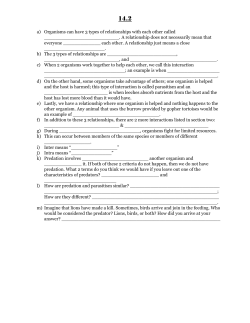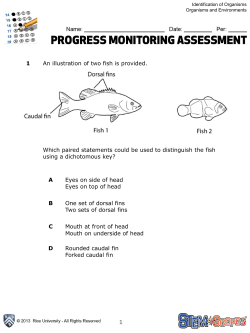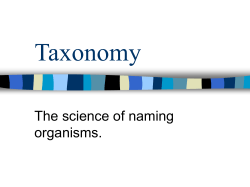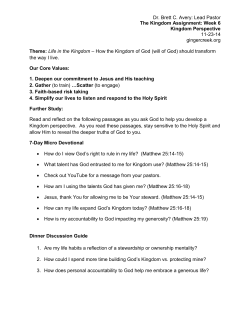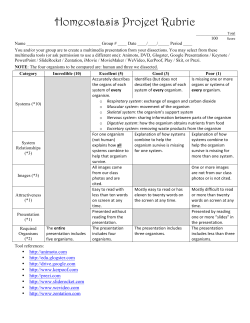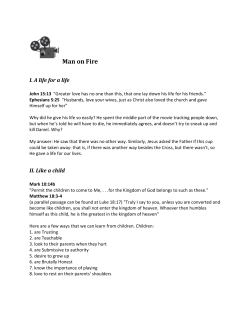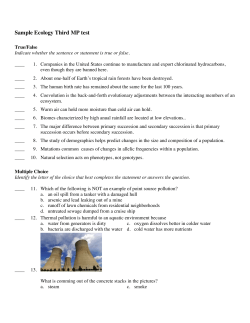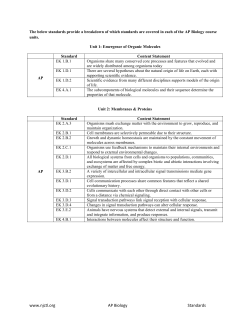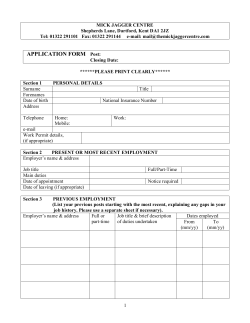
Classification 1
Classification 1 MRS C GREN Living organisms are able to perform all of MRS C GREN and non living cannot. 2 M R S C G R E N = movement = reproduction = sensing = circulation = growth = respiration = excretion = nutrition 3 Movement is action carried out by a living organism e.g. a flower opening or a horse walking 4 Reproduction is the ability of living organisms to make offspring which are similar to the parents 5 Sensing is the detection and response to changes in the environment 6 Circulation is the movement of substances (food, gases, waste) within an organism 7 Growth is change in an organism over time 8 Respiration is the use of energy from food molecules 9 Excretion is the removal of waste produced by the organism 10 Nutrition is making or getting food inside an organism 11 Differences between plants and animals • Animals - Are usually mobile and able to move limbs quickly - Obtain energy by eating other organisms 12 • Have a nervous system and brain • Have well developed sense organs 13 • Plants - Usually fixed or floating, can move some parts slowly - Make their own food using light 14 • Have no nervous system or brain • Have no special sense organs 15 Grouping living things There are trillions of living organisms on Earth. They are sorted into smaller groups called species. The organisms in a species have common structures and behaviours and can breed together to make fertile offspring. 16 • Dogs of different breeds look very different but they can all mate and produce fertile puppies. All dogs belong to one species. 17 • Horses and donkeys look and behave similarly and they can mate to produce offspring called mules. Mules are infertile therefore horses and donkeys are different species. 18 So far scientists have identified about two million species. This is still a large number so closely related species are grouped into a genus. Similar genera are grouped into a family. Similar families are grouped into an order. 19 Similar orders are grouped into a class. Similar classes are grouped into a phylum. And similar phyla are grouped into kingdoms. There are five living kingdoms. 20 The Five Living Kingdoms Plants Animals Protista All living organisms Monera Fungi 21 22 The Five Living Kingdoms • Animal Kingdom • Plant Kingdom • Fungi Kingdom • Protista Kingdom • Monera Kingdom 23 Animal Kingdom • Multicellular with a nucleus • Moving bodies and parts • Eat other organisms for food 24 Animal Kingdom 25 Plant Kingdom • Multicellular with a nucleus • Immobile but have moving parts • Make their own food 26 27 Fungi Kingdom • Multicellular with a nucleus • Immobile • Eat other organisms for food (external digestion) 28 29 Protista Kingdom • Single celled organisms with a nucleus • Mobile • Some eat other cells • Some make own food (algae) 30 31 Monera Kingdom (Bacteria) • Single celled with no nucleus • Some are mobile • Have a range of different feeding methods 32 33 Binomial naming system Every species is given a unique species name to avoid confusion. This name has two parts and is given in Latin. For example, pine trees are named Pinus radiata and people are called Homo sapiens 34 Find out the common name of these NZ organisms • Diomeda epomophora = Royal Albatross • Agathis australis = Kauri • Ninox novaeseelandiae = Morepork 35 Find out the common name of these NZ organisms • Cordyline australis = Cabbage Tree (Ti Kouka) • Podocarpus totara = Totara • Apteryx australis = Brown Kiwi 36 Dichotomous key Keys are used to identify unknown objects or put them into groups. A dichotomous key has a series of questions which have two alternative answers. 37 38 39 They can take up a lot of room! 40 A dichotomous key to identify a duck, a hen, a lizard and a snake 41 Classifying animals All animals Animals with backbones Animals without backbones 42 Write the group to which each animal belongs. Mammal Amphibian Reptile Sample Dichotomous Key I. Body covering Aves A. not covered with hair or feathers - go to II B. covered with hair or feathers - go to III II. Skin Texture A. smooth - Amphibian B. scaly - Reptile III. Skin Features A. covered with feathers - Aves B. covered with hair - Mammal 43 Construct a dichotomous key Construct your own dichotomous key to classify the contents of your pencil case. 44 Dichotomous key for stationery 1a. Item made of at least some metal???????.go to 2 1b. Item does not contain any metal??...............??go to 6 2a. Item used as writing instrument?????..??go to 3 2b. Item not used as writing instrument????...?..go to 4 3a. Item writes with ink?????...............????ballpoint pen 3b. Item writes with carbon?????..?...............?pencil 4a. Item has sharp cutting edge?????...............?scissors 4b. Item does not have a sharp, cutting edge?..............go to 5 5a. Item has a sharp, pointed end???............???thumb tack 5b. Item does not have a sharp, pointed end??.....?..paper clip 6a. Item is hard?????..........????????.go to 7 6b. Item is not hard ?????..........??????..rubber band 7a. Item is numbered in equal divisions???.....??ruler 7b. Item not numbered in equal divisions??..........?go to 8 8a. Item can write on paper????..............???..pencil 8b. Item can't write on paper???........................?..go to 9 9a. Item has a sticky, central core?????....??..glue stick 9b. Item does not have a sticky, central core?.......?..eraser 45
© Copyright 2025
